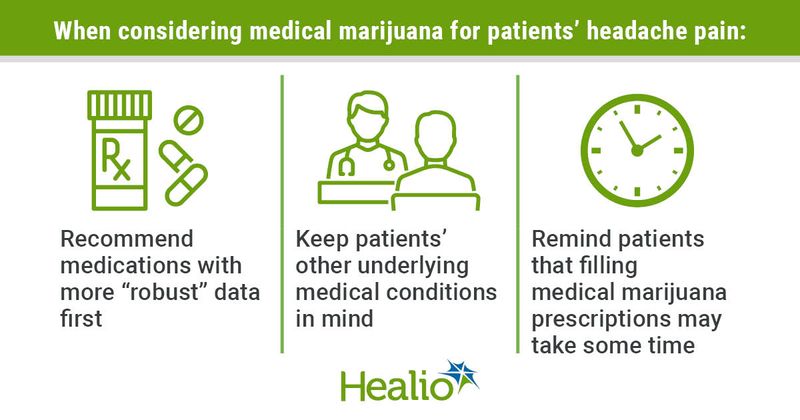Medical marijuana often replaces other headache medications, small study shows
Most patients in a small cohort used medical marijuana in lieu of other abortive medications to alleviate migraine pain, according to recent findings.
The study was presented at the virtual American Headache Society Annual Scientific Meeting.

Angela Y. Hou, a headache fellow at Jefferson Headache Center at Thomas Jefferson University Hospital in Philadelphia, and colleagues reviewed medical records and questionnaires completed by 28 patients with migraine who initiated medical marijuana treatment. They interviewed the patients several months later to identify trends and health outcomes associated with medical marijuana use.

The researchers found that of the 25 patients who were still using medical marijuana at the time of the follow-up interview, 25% said they used it daily and 71.4% used it at least twice weekly. Before using medical marijuana, 46.4% of patients were using abortive medications 10 or more days monthly; only 25% did so after starting medical marijuana treatment, according to the researchers. Half of the patients used a THC-dominant strain of the substance and 71.4% used an inhaled form. The most common adverse events reported were dry mouth/throat (46.4%), dry/red eyes and fatigue/lethargy (35.7% each) and increased appetite (35.7%).
Most patients reported that their previously existing anxiety (57.1%) and insomnia (78.6%) improved after using medical marijuana. When asked to rate how helpful medical marijuana was on a scale of 1 to 10, nearly 18% rated it a 10 (average rating = 5.9).
Still, Hou recommends that patients use more standard headache treatments before considering medical marijuana.
“Prior to a discussion about using medical marijuana, I usually recommend that patients try anticonvulsants, antidepressants, antihypertensives, calcitonin gene-related peptide antagonists and onabotulinumtoxinA for preventing headaches,” she told Healio Primary Care.
Antiemetics, ergots, triptans and NSAIDs should be tried first for aborting headaches, she added.
“These more standard medications have more robust literature and research behind their use,” Hou said.
“I would be cautious about recommending medical marijuana to a patient who has a history of a substance abuse disorder,” she continued. “Patients who have an underlying lung disease should also be cautioned against using inhaled forms of medical marijuana [but] could try tinctures and topicals.”
Hou said physicians should advise patients that filling prescriptions for medical marijuana may take some time.
“Getting medical marijuana is a multi-step process that may vary by state and takes a significant amount of time and effort on the part of the patient,” she said. “Physicians are only able to make general recommendations regarding the type and formulation of medical marijuana, with the actual specifics decided by the patient at the time he or she visits a dispensary.”

